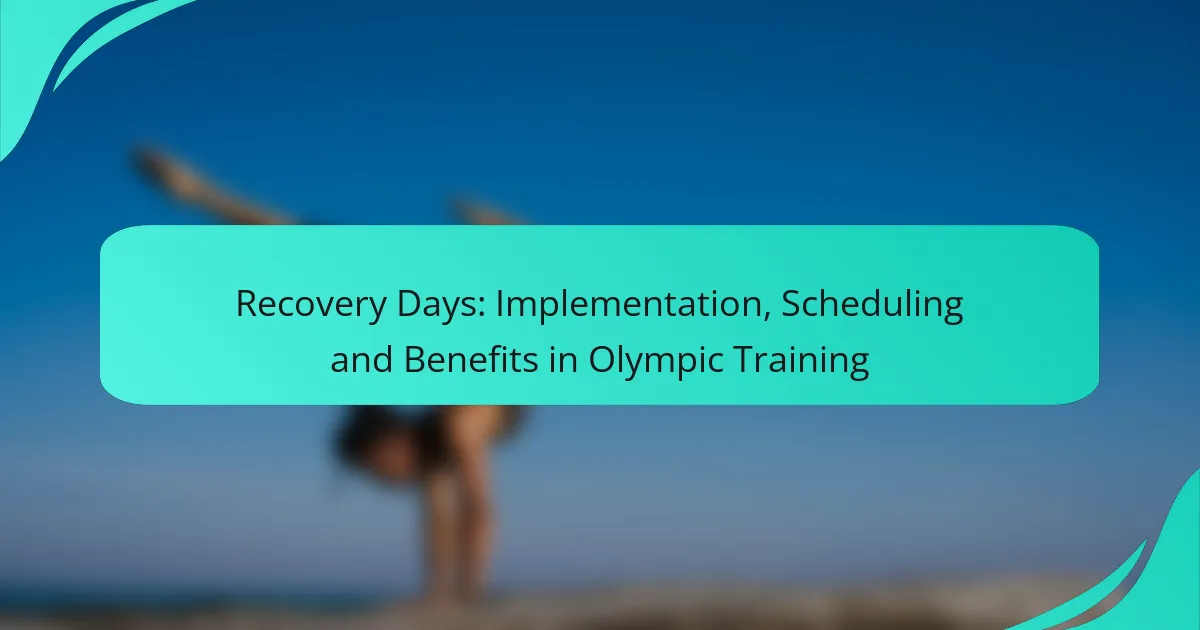Recovery days play a vital role in Olympic training, serving to optimize performance and minimize the risk of injuries. Strategically scheduled to align with an athlete’s training cycle, these days are crucial for muscle repair and mental rejuvenation, ultimately enhancing overall performance and well-being.

How to implement recovery days in Olympic training?
Implementing recovery days in Olympic training is essential for optimizing performance and preventing injuries. These days should be strategically scheduled and tailored to the athlete’s training cycle and individual needs.
Structured recovery protocols
Structured recovery protocols involve planned rest periods that align with training intensity and volume. Athletes should aim for at least one full recovery day per week, adjusting based on their training load and competition schedule.
Common protocols include alternating high-intensity training days with lower-intensity sessions or complete rest. This helps in muscle repair and mental rejuvenation, ensuring athletes remain at peak performance levels.
Incorporating active recovery
Active recovery includes low-intensity activities that promote blood flow and reduce muscle soreness without adding significant strain. Examples include light jogging, swimming, or yoga, typically performed on days following intense workouts.
Incorporating active recovery can enhance flexibility and mobility, aiding in overall recovery. Athletes should consider dedicating 20-30 minutes to these activities, ensuring they remain engaged without overexerting themselves.
Utilizing rest days effectively
Effective use of rest days involves more than just avoiding physical activity; it includes proper nutrition, hydration, and sleep. Athletes should focus on consuming balanced meals rich in carbohydrates and proteins to support recovery.
Additionally, mental recovery is crucial. Engaging in relaxation techniques, such as meditation or light stretching, can help athletes recharge mentally. It’s important to avoid the temptation to engage in strenuous activities on rest days to maximize recovery benefits.

What is the ideal schedule for recovery days in Olympic training?
The ideal schedule for recovery days in Olympic training typically involves incorporating one to two recovery days each week, depending on the intensity and volume of training. These days are crucial for muscle repair, mental rejuvenation, and overall performance enhancement.
Weekly training cycle adjustments
Adjusting the weekly training cycle is essential for optimizing recovery. Athletes should consider their training load and intensity when scheduling recovery days. A common approach is to alternate high-intensity days with lower-intensity or recovery-focused sessions, allowing the body to adapt and recover effectively.
For example, an athlete might train intensely for three days, followed by a lighter day focused on technique or flexibility, and then take a complete rest day. This cycle can help prevent overtraining and reduce the risk of injury.
Periodization strategies for recovery
Periodization strategies involve planning training phases that include specific recovery periods. Olympic athletes often use macro, meso, and micro cycles to structure their training, ensuring that recovery is built into each phase. This approach allows for peak performance during competitions while maintaining overall health.
For instance, during a macro cycle, an athlete may focus on building strength for several weeks, followed by a tapering phase that includes more recovery days. This structured approach helps manage fatigue and enhances long-term performance.
Timing recovery days around competitions
Timing recovery days around competitions is critical for maximizing performance. Athletes should schedule recovery days immediately following intense training sessions or competitions to facilitate muscle repair. This can include active recovery, such as light swimming or yoga, to promote blood flow without adding stress.
In the lead-up to a competition, it’s advisable to increase recovery days to ensure athletes are well-rested. A common practice is to reduce training volume and intensity in the week prior to a major event, allowing for optimal performance on competition day.

What are the benefits of recovery days for Olympic athletes?
Recovery days are essential for Olympic athletes as they enhance overall performance, reduce injury risk, and improve mental well-being. By allowing the body to rest and repair, athletes can maintain peak physical condition and mental clarity throughout their training cycles.
Enhanced performance and endurance
Recovery days contribute significantly to enhanced performance and endurance by allowing muscles to repair and replenish energy stores. During intense training, muscle fibers experience micro-tears, and recovery days facilitate the healing process, leading to stronger muscles and improved stamina.
Incorporating rest days into a training schedule can lead to noticeable gains in strength and endurance. Athletes may find that alternating between high-intensity workouts and recovery days helps them push their limits without overtraining, ultimately resulting in better performance during competitions.
Reduced risk of injury
Taking recovery days is crucial for reducing the risk of injuries, which can derail an athlete’s training and competitive plans. Continuous training without adequate rest can lead to overuse injuries, such as tendonitis or stress fractures, which are common among elite athletes.
To minimize injury risk, athletes should listen to their bodies and incorporate active recovery techniques, such as light stretching or low-impact activities, on their rest days. This approach not only aids in recovery but also helps maintain flexibility and mobility, further protecting against injuries.
Improved mental health and focus
Recovery days play a vital role in improving mental health and focus for Olympic athletes. Intense training can lead to mental fatigue and burnout, which can negatively impact performance. Regular rest days allow athletes to recharge mentally, fostering a more positive mindset.
Additionally, taking time off from rigorous training can enhance concentration and motivation. Athletes may benefit from engaging in relaxing activities or hobbies during recovery days, which can help them return to training with renewed energy and a clearer focus on their goals.

How do recovery days differ for various Olympic sports?
Recovery days vary significantly across Olympic sports due to differences in physical demands, training intensity, and competition schedules. Each sport requires tailored recovery strategies to optimize performance and prevent injury, reflecting the unique needs of athletes in disciplines such as swimming, gymnastics, and athletics.
Sport-specific recovery strategies
Different Olympic sports implement unique recovery strategies based on their specific demands. For instance, swimmers often utilize active recovery techniques like light swimming or stretching to maintain muscle flexibility, while weightlifters may focus on complete rest or low-intensity mobility work. Gymnasts might incorporate yoga or Pilates to enhance core strength and flexibility during recovery.
Additionally, team sports like basketball or soccer may prioritize group recovery sessions, including ice baths or massage therapy, to foster camaraderie and collective healing. Understanding these sport-specific strategies is crucial for athletes to maximize their recovery potential.
Intensity and volume considerations
The intensity and volume of training directly influence the type of recovery required. High-intensity sports, such as sprinting or weightlifting, often necessitate longer recovery periods to allow for muscle repair and energy replenishment. Athletes in these disciplines might take one to two days of active recovery after intense training sessions.
Conversely, endurance sports like long-distance running may allow for shorter recovery times, as the training volume is typically lower in intensity but higher in duration. Athletes in these sports might benefit from lighter recovery runs or cross-training activities to facilitate recovery without excessive strain.
Case studies from track and field
In track and field, recovery strategies can vary widely among events. Sprinters often engage in targeted recovery protocols, including ice baths and compression therapy, to reduce muscle soreness after explosive workouts. They may schedule recovery days that include low-impact activities, such as cycling or swimming, to maintain cardiovascular fitness while allowing muscles to recover.
In contrast, distance runners might incorporate longer recovery runs at a conversational pace, focusing on maintaining aerobic fitness without overexertion. A common practice is to alternate between hard training days and easy recovery days, ensuring that athletes remain fresh and ready for competition. This tailored approach helps prevent burnout and injuries, enhancing overall performance in track and field events.

What criteria should be considered when scheduling recovery days?
When scheduling recovery days, it’s essential to consider the individual needs of the athlete, the training load they have experienced, and the metrics used to assess their recovery. These factors help ensure that recovery days are effectively integrated into training programs to optimize performance and prevent injury.
Individual athlete needs
Each athlete has unique physiological and psychological requirements that influence their recovery. Factors such as age, fitness level, and training history should be assessed to tailor recovery days appropriately. For instance, younger athletes may require more frequent recovery compared to seasoned competitors.
Additionally, personal preferences and lifestyle factors, such as work commitments or family obligations, can impact how recovery days are scheduled. Understanding these individual needs can help coaches create a more effective training plan.
Training load monitoring
Monitoring training load is crucial for determining when recovery days are necessary. This involves tracking the intensity, duration, and frequency of workouts to assess overall stress on the body. Tools such as heart rate monitors and training logs can provide valuable data to guide recovery scheduling.
A common approach is to use a ratio of training load to recovery, ensuring that athletes have adequate downtime after high-intensity sessions. For example, a typical guideline might suggest one recovery day for every three to five days of intense training.
Recovery metrics and assessments
Utilizing recovery metrics helps determine an athlete’s readiness to train again. Common assessments include subjective measures like perceived exertion and objective metrics such as heart rate variability and sleep quality. These indicators can signal when an athlete is adequately recovered or may need additional rest.
Regularly assessing these recovery metrics allows coaches to adjust training plans dynamically. For instance, if an athlete shows signs of fatigue or elevated resting heart rates, it may be prudent to schedule an additional recovery day to prevent overtraining.

How can technology assist in recovery day planning?
Technology can significantly enhance recovery day planning by providing real-time data on an athlete’s physiological state and recovery needs. Tools such as apps and devices help track metrics like heart rate variability, sleep quality, and muscle soreness, enabling tailored recovery strategies.
Wearable devices for monitoring
Wearable devices play a crucial role in monitoring an athlete’s recovery status. These gadgets, such as fitness trackers and smartwatches, can measure heart rate, sleep patterns, and activity levels, providing insights into how well an athlete is recovering. For instance, a device that tracks heart rate variability can indicate stress levels and recovery readiness.
When selecting a wearable device, consider factors like battery life, comfort, and compatibility with other training tools. Popular options include the Garmin Forerunner series and the WHOOP strap, both known for their accuracy and user-friendly interfaces. Athletes should aim for devices that offer comprehensive data while being easy to integrate into their training routines.
To maximize the benefits of wearable devices, athletes should regularly review their data and adjust their recovery strategies accordingly. For example, if a device indicates poor sleep quality, it may be beneficial to incorporate additional rest or relaxation techniques into the recovery day. Avoid relying solely on one metric; a holistic view of recovery is essential for optimal performance.
